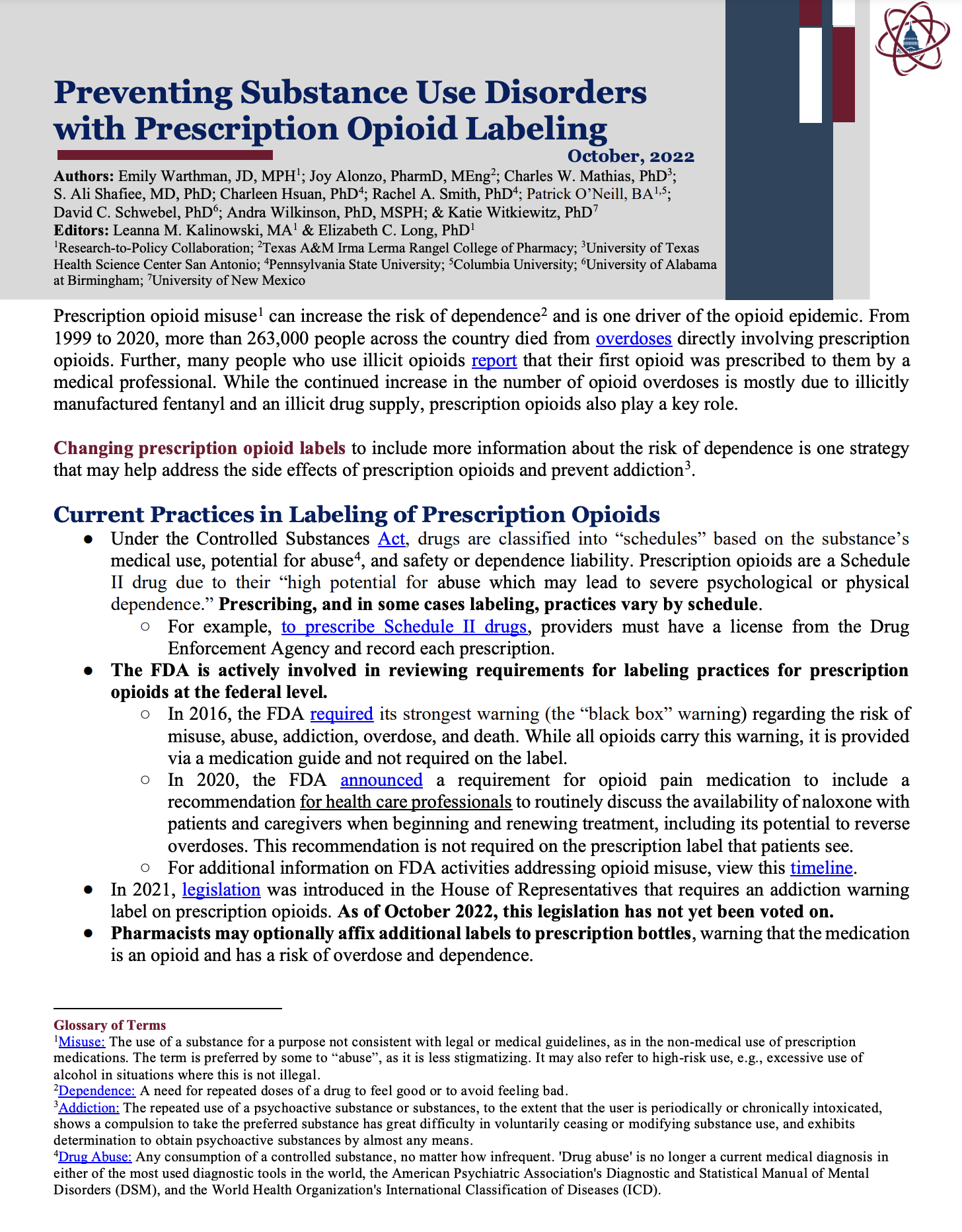
Prescription opioid misuse[1] can increase the risk of dependence[2] and is one driver of the opioid epidemic. From 1999 to 2020, more than 263,000 people across the country died from overdoses directly involving prescription opioids. Further, many people who use illicit opioids report that their first opioid was prescribed to them by a medical professional. While the continued increase in the number of opioid overdoses is mostly due to illicitly manufactured fentanyl and an illicit drug supply, prescription opioids also play a key role.
Changing prescription opioid labels to include more information about the risk of dependence is one strategy that may help address the side effects of prescription opioids and prevent addiction[3].
Current Practices In Labeling Of Prescription Opioids
- Under the Controlled Substances Act, drugs are classified into “schedules” based on the substance’s medical use, potential for abuse[1], and safety or dependence liability. Prescription opioids are a Schedule II drug due to their “high potential for abuse which may lead to severe psychological or physical dependence.” Prescribing, and in some cases labeling, practices vary by schedule.
- For example, to prescribe Schedule II drugs, providers must have a license from the Drug Enforcement Agency and record each prescription.
- The FDA is actively involved in reviewing requirements for labeling practices for prescription opioids at the federal level.
- In 2016, the FDA required its strongest warning (the “black box” warning) regarding the risk of misuse, abuse, addiction, overdose, and death. While all opioids carry this warning, it is provided via a medication guide and not required on the label.
- In 2020, the FDA announced a requirement for opioid pain medication to include a recommendation for health care professionals to routinely discuss the availability of naloxone with patients and caregivers when beginning and renewing treatment, including its potential to reverse overdoses. This recommendation is not required on the prescription label that patients see.
- For additional information on FDA activities addressing opioid misuse, view this timeline.
- In 2021, legislation was introduced in the House of Representatives that requires an addiction warning label on prescription opioids. As of October 2022, this legislation has not yet been voted on.
- Pharmacists may optionally affix additional labels to prescription bottles, warning that the medication is an opioid and has a risk of overdose and dependence.
Impact Of Prescription Labeling & Strategies To Increase Its Effectiveness.
- Currently, there is limited evidence to support the use of labeling practices as an effective means of reducing these harms, which may, in part, be due to the recency of legislation regulating labeling.
- Labeling practices need to balance warnings about the potential for dependence with potential stigmatization of patients who need treatment for chronic pain, as well as the potential fear and avoidance of taking opioids for pain treatment.
- Pediatric exposure to prescription opioids is another concern. Children should not have access to, nor self-administer opioids of any kind. Including this statement on prescription opioid bottles may prevent children from accessing them.
Considerations For Policymakers
- Fund evaluations of current and proposed opioid labeling strategies to determine their effectiveness and best practices.
- Require pharmacists to use a special cap to identify the medication as an opioid. For example, a red cap is required for Schedule II opioids in Arizona, per state law.
- Adding information about the risk of dependence to opioid labels is one strategy that should be used in combination with other prevention, treatment, and harm reduction methods (e.g., supporting policies that promote peer support services, increased availability of naloxone, etc.) to have the greatest impact.
Glossy Of Terms
[1]Misuse: The use of a substance for a purpose not consistent with legal or medical guidelines, as in the non-medical use of prescription medications. The term is preferred by some to “abuse”, as it is less stigmatizing. It may also refer to high-risk use, e.g., excessive use of alcohol in situations where this is not illegal.
[2]Dependence: A need for repeated doses of a drug to feel good or to avoid feeling bad.
[3]Addiction: The repeated use of a psychoactive substance or substances, to the extent that the user is periodically or chronically intoxicated, shows a compulsion to take the preferred substance has great difficulty in voluntarily ceasing or modifying substance use, and exhibits determination to obtain psychoactive substances by almost any means.
[4]Drug Abuse: Any consumption of a controlled substance, no matter how infrequent. ‘Drug abuse’ is no longer a current medical diagnosis in either of the most used diagnostic tools in the world, the American Psychiatric Association’s Diagnostic and Statistical Manual of Mental Disorders (DSM), and the World Health Organization’s International Classification of Diseases (ICD).
The Research-to-Policy Collaboration (RPC) works to bring together research professionals and public officials to support evidence-based policy. Please visit their website to learn more.
Key Information
RPC Website
Research-to-Policy Collaboration
Publication DateOctober 1, 2022
Topic Area(s)Substance Use and Misuse
Resource TypeWritten Briefs
Share This Page
Prescription opioid misuse[1] can increase the risk of dependence[2] and is one driver of the opioid epidemic. From 1999 to 2020, more than 263,000 people across the country died from overdoses directly involving prescription opioids. Further, many people who use illicit opioids report that their first opioid was prescribed to them by a medical professional. While the continued increase in the number of opioid overdoses is mostly due to illicitly manufactured fentanyl and an illicit drug supply, prescription opioids also play a key role.
Changing prescription opioid labels to include more information about the risk of dependence is one strategy that may help address the side effects of prescription opioids and prevent addiction[3].
Current Practices In Labeling Of Prescription Opioids
- Under the Controlled Substances Act, drugs are classified into “schedules” based on the substance’s medical use, potential for abuse[1], and safety or dependence liability. Prescription opioids are a Schedule II drug due to their “high potential for abuse which may lead to severe psychological or physical dependence.” Prescribing, and in some cases labeling, practices vary by schedule.
- For example, to prescribe Schedule II drugs, providers must have a license from the Drug Enforcement Agency and record each prescription.
- The FDA is actively involved in reviewing requirements for labeling practices for prescription opioids at the federal level.
- In 2016, the FDA required its strongest warning (the “black box” warning) regarding the risk of misuse, abuse, addiction, overdose, and death. While all opioids carry this warning, it is provided via a medication guide and not required on the label.
- In 2020, the FDA announced a requirement for opioid pain medication to include a recommendation for health care professionals to routinely discuss the availability of naloxone with patients and caregivers when beginning and renewing treatment, including its potential to reverse overdoses. This recommendation is not required on the prescription label that patients see.
- For additional information on FDA activities addressing opioid misuse, view this timeline.
- In 2021, legislation was introduced in the House of Representatives that requires an addiction warning label on prescription opioids. As of October 2022, this legislation has not yet been voted on.
- Pharmacists may optionally affix additional labels to prescription bottles, warning that the medication is an opioid and has a risk of overdose and dependence.
Impact Of Prescription Labeling & Strategies To Increase Its Effectiveness.
- Currently, there is limited evidence to support the use of labeling practices as an effective means of reducing these harms, which may, in part, be due to the recency of legislation regulating labeling.
- Labeling practices need to balance warnings about the potential for dependence with potential stigmatization of patients who need treatment for chronic pain, as well as the potential fear and avoidance of taking opioids for pain treatment.
- Pediatric exposure to prescription opioids is another concern. Children should not have access to, nor self-administer opioids of any kind. Including this statement on prescription opioid bottles may prevent children from accessing them.
Considerations For Policymakers
- Fund evaluations of current and proposed opioid labeling strategies to determine their effectiveness and best practices.
- Require pharmacists to use a special cap to identify the medication as an opioid. For example, a red cap is required for Schedule II opioids in Arizona, per state law.
- Adding information about the risk of dependence to opioid labels is one strategy that should be used in combination with other prevention, treatment, and harm reduction methods (e.g., supporting policies that promote peer support services, increased availability of naloxone, etc.) to have the greatest impact.
Glossy Of Terms
[1]Misuse: The use of a substance for a purpose not consistent with legal or medical guidelines, as in the non-medical use of prescription medications. The term is preferred by some to “abuse”, as it is less stigmatizing. It may also refer to high-risk use, e.g., excessive use of alcohol in situations where this is not illegal.
[2]Dependence: A need for repeated doses of a drug to feel good or to avoid feeling bad.
[3]Addiction: The repeated use of a psychoactive substance or substances, to the extent that the user is periodically or chronically intoxicated, shows a compulsion to take the preferred substance has great difficulty in voluntarily ceasing or modifying substance use, and exhibits determination to obtain psychoactive substances by almost any means.
[4]Drug Abuse: Any consumption of a controlled substance, no matter how infrequent. ‘Drug abuse’ is no longer a current medical diagnosis in either of the most used diagnostic tools in the world, the American Psychiatric Association’s Diagnostic and Statistical Manual of Mental Disorders (DSM), and the World Health Organization’s International Classification of Diseases (ICD).
The Research-to-Policy Collaboration (RPC) works to bring together research professionals and public officials to support evidence-based policy. Please visit their website to learn more.

Key Information
RPC Website
Research-to-Policy Collaboration
Publication DateOctober 1, 2022
Topic Area(s)Substance Use and Misuse
Resource TypeWritten Briefs
Share This Page
LET’S STAY IN TOUCH
Join the Evidence-to-Impact Mailing List
Keep up to date with the latest resources, events, and news from the EIC.




